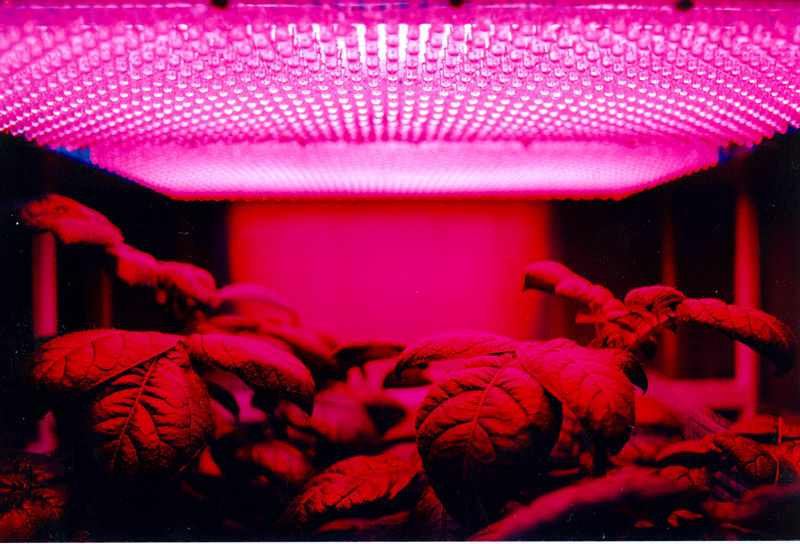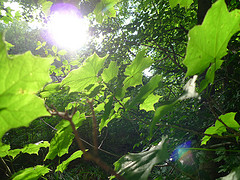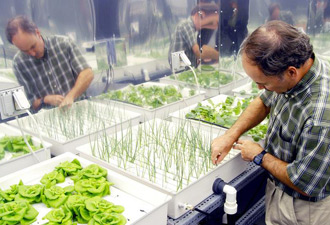The nearside of the Moon will never resemble your Granddad's back forty, but agriculture remains the key to living and working off-world. All the mineral ore in the solar system can't replace the fact that for extended periods on the Moon or Mars, future off-worlders will need bio-regenerative systems in order to prosper.
Here on earth, researchers still debate how best to make those possible, but nuclear-powered state of the art LED (Light-emitting Diode) technology is arguably what will drive photosynthesis so necessary to provide both food and oxygen for future lunar colonists.
Future long-term lunar residents will need to grow their food either in sub-lunar lava tubes or in greenhouses shielded with several meters of lunar surface regolith. With no atmosphere, the moon is regularly exposed to lethal doses of cosmic rays, solar coronal mass ejections and x-flares, not to mention micro-meteorites that would be enough to wreck anyone's corn.
Although during the two weeks that make up the long lunar day astronauts might be able to funnel refracted sunlight into covered greenhouses or subsurface lava tunnels, they will be left without a light source during the long lunar night.

LED panel light source used in an experiment on plant growth by NASA. Pictured plant is a potato plant.(Photo credit: Wikipedia)
Cary Mitchell, a plant biologist at Purdue University, says that as lunar light sources, LEDs would be cool, solid state and robust; lasting 50,000 hours at least, or some five times longer than conventional horticultural light sources. He also notes that that they could survive the journey to the lunar surface where they could then be strung inside inflatable lava tunnel greenhouses or in radiation-hardened, solid greenhouses on the surface.
On earth, Mitchell says it takes roughly 50 square meters of agriculture to provide both food and oxygen life to support one human. But, as he points out, who can say how productive plants are ultimately going to be on the moon, in gravity that is only one sixth that of earth?

Photosynthesis (Photo credit: dmott9)
"Through photosynthesis, plants produce oxygen and also scavenge carbon dioxide out of the air," said Mitchell. "Light LEDs can provide the energy to drive all of that."
As for water?
Mitchell says if water can be generated onsite so much the better but, if not, it would need to be brought from earth and continually recycled.
Whether future lunar farmers will be able to use the lunar regolith to grow their crops also remains uncertain. The upper portions of the lunar regolith are largely composed of pulverized micro-meteorites collected over billions of years.
"I suspect most plants would do well in the regolith if the missing nutrients were supplied," said plant physiologist Ray Wheeler, the lead for Advanced Life Support activities at NASA's Kennedy Space Center. "Unfortunately, most of the necessary nutrients for plant growth would probably have to be added. Some elements, such as iron, calcium and potassium might be released as the regolith weathers and breaks down at bit [in a greenhouse atmosphere]."

NASA researcher checking hydroponic onions with Bibb lettuce to his left and radishes to the right (Photo credit: Wikipedia)
And even if the lunar regolith doesn't make a very successful substitute for the long-weathered soils here on earth, the researchers remain confident that they could still grow most of what they need hydroponically. That is, as long as they had access to needed liquid fertilizers and workable LEDs.
"For us, it's not just sticking a plant under an LED," said Kevin Folta, a horticulturalist at the University of Florida who conducts research in off-world farming. "It's telling the plant how to grow by controlling the quantities and colors of lights we deliver. That's a huge advantage in a lunar setting where you want lots of leaves on your lettuce."
LEDs also allow growers to tailor their light spectrum to manipulate and maximize certain plant attributes, thereby increasing a plant's given nutraceutical content.
Even so, Michele Perchonok, a food scientist at NASA's Johnson Space Center, says the U.S. space agency would likely only grow fruits and vegetables such as potatoes, strawberries, cherry tomatoes; salad greens, carrots, and bell peppers in hydroponically-equipped lunar greenhouses. She says they would most likely transport earth-grown soybeans, wheat and peanuts to such a lunar colony in bulk.
"Some of these plants take three months to grow," said Perchonok. "So, it makes no sense to start building growth chambers or greenhouses if all you're doing is one six-month stay. It doesn't give you a good return on your investment unless you plan to have an ongoing habitat."
Still, Folta says the biggest challenge would be getting sufficient light to support crops like tomatoes and corn that require lots of photosynthesis.
However, if the lunar base were on the rim of the Shackleton Crater near the moon's South Pole, Wheeler says, there might be sunlight available for as long as 24 days at the time. But as he acknowledges, such ideas will require a very long-term outlook.
"To set up the [lunar agricultural] infrastructure, initial capital investments would be very high," said Wheeler. "But conceivably, because of the reduced launch costs (under lower gravity), the moon could also be a lower cost agricultural production spot for interplanetary space travelers in the distant future."





